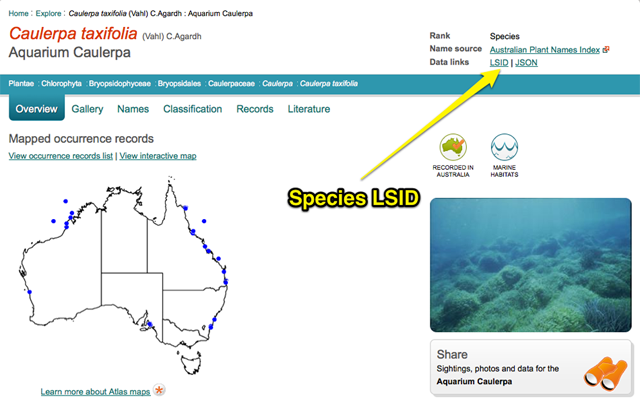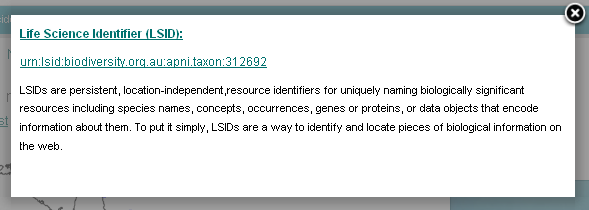You can import or upload an assemblage of LSIDs in a CSV file to the Spatial Portal.
The intention is to generalize the functionality to cater for an assemblage described by any combination of scientific names, Common names and LSIDs similar to the current Search for multiple species by scientific or common name.
Life Science Identifiers (LSIDs)
An LSID is a persistent, unique identifier used for identifying any piece of biological information on the web.
For more information, consult the TDWG wiki.
For example:
urn:lsid:biodiversity.org.au:afd.taxon:40edb8f3-9bf2-40f9-b261-1d53648f3056
The Atlas uses Life Science Identifiers (LSIDs) for taxa – the scientific names that a taxonomist has published in a journal paper. A taxon is a publication stating the author’s opinion on the use and hierarchical placement of a Scientific Name, including it’s synonyms and other names used to describe the organism to which the name applies. Note, other taxonomists describing the same group of organisms could compile a different set of taxa which may include many of the same scientific names in a different usage. The Atlas is sponsoring the development of lists of ‘accepted’ taxa, using the Atlas’ tools and infrastructure, to provide the scientific community’s consensus view for Australian biota.
Why use LSIDs? They uniquely describe a taxa in the Atlas of Living Australia (and everywhere else) and are herefore unambiguous when it comes to nominating taxa for use in assemblages.
The imported LSIDs are matched against the National Species Lists of the Atlas to identify the accepted scientific names of taxa deemed to be the interim ‘accepted’ concepts for taxa, or the acknowledged ‘accepted’ taxa by the consensus committee.
These accepted scientific names whether at species level or higher, will be added to the generated species layer. This active ‘species’ layer is only stored for the current session.
Note: Any other uploaded LSIDs, representing ‘non-accepted’ taxa e.g. synonyms, or invalid LSIDs will be ignored.
Import Assemblage
To import LSIDs directly into Spatial Portal, on the menu select ‘Import’ and then ‘Assemblage’.

Then enter a name for the data set (which will be used as the name of the active layer), enter a description of the data set (which will be used in the layer metadata).
Press the ‘Next’ button, then browse to find the CSV file containing the LSIDs.
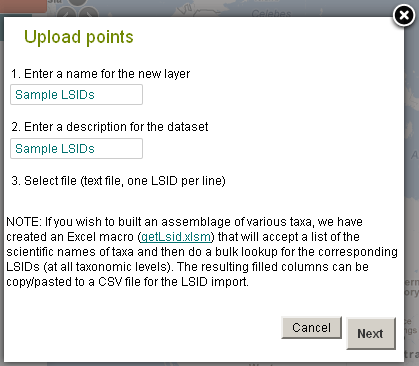
The dialogue window provides the suggestion to use the getLsid.xlsm macro.
See introduction to the macro below »
Upload LSIDs
Using this option, the user can upload a text file containing a list of Life Sciences Identifiers (LSIDs) in CSV format. This option is part of dialogue for adding species to a map, or in several of the tools/export options.
Select ‘Upload LSIDs’ and then press the ‘Next’ button, then browse to find the CSV file containing the LSIDs.
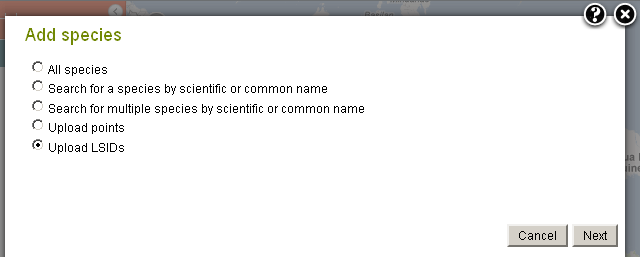
The ‘Upload LSIDs’ option uses a comma separated value (CSV) file containing each LSID on a separate line.

Shown in the demo_LSID_upload.csv file.
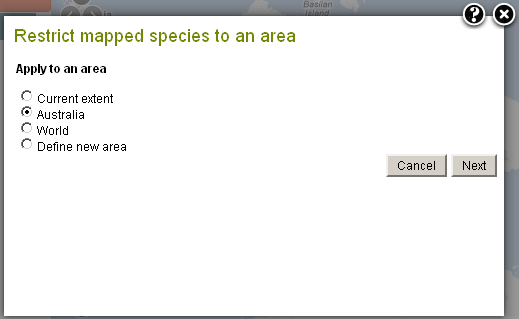
Once the LSIDs have been loaded:
- The points are mapped
- The data is listed as a mapped layer using the name entered for the import/upload LSIDs dialogue screen, or for tools/export the name of the csv file
- Metadata will be created from the uploaded information
- The layer is available for sampling of environmental and/or contextual values, scatterplots, prediction or points to grid.
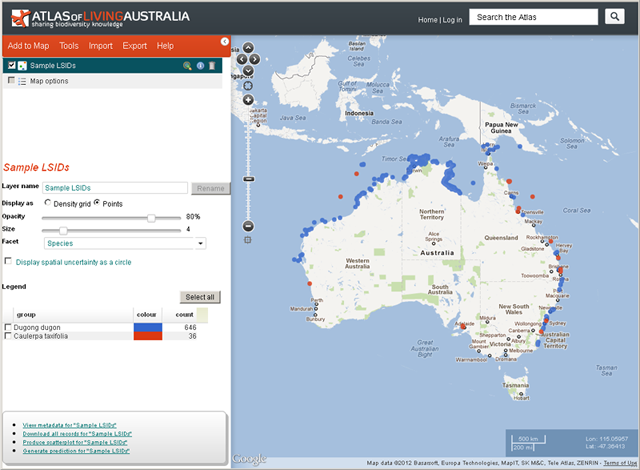
The two species represented by the LSIDs are displayed on the map. The map has been faceted to show the different species by selecting ‘Species’ from the Facet pull-down list.
Layer Metadata
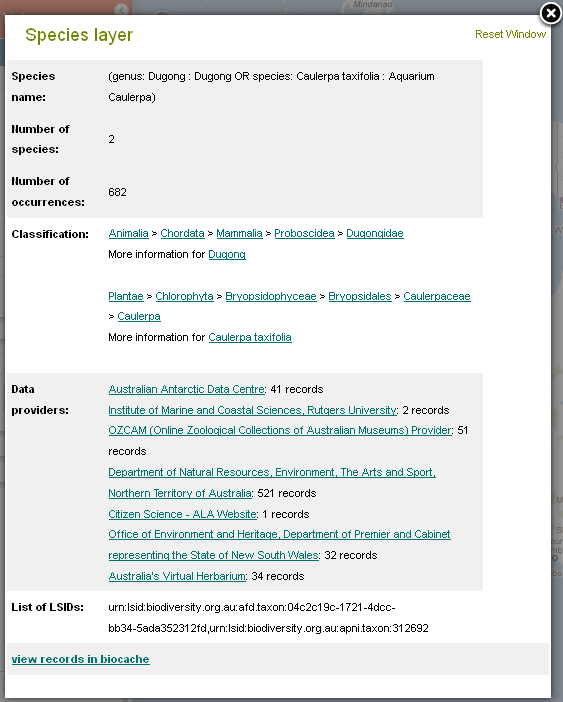
Links in this window will provide further details and will open in a new window.
When the layer metadata icon ![]() icon is selected in the layers list for the imported LSIDs or a created layer the metadata is displayed.
icon is selected in the layers list for the imported LSIDs or a created layer the metadata is displayed.
Other ways to discover LSIDs for scientific names
Macro to produce LSIDs
A Windows Excel macro (getLsid.zip) automates the process of producing a list of LSIDs. It looks up a list of scientific names, and produces for each scientific name the LSID of the ‘accepted’ matching taxon. These LSIDs can be copied to a CSV file for import/upload. See the getLSID Spreadsheet Macro »
National Species List Web Services
Another way to discover the LSID of a taxon concept is by using the ALA National Species List services. The name resolution service to access the current taxon concept for a scientific name.
For more information, see the National Species Lists »
Atlas Species Profile pages
To discover the ‘accepted’ taxon LSID used in the Atlas and the Spatial Portal, find your species of interest in the Species Profile pages. Press on the LSID link shown in the figure below. Record the LSID for use in the ‘Upload LSIDs’ CSV file.
